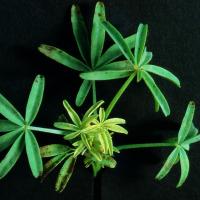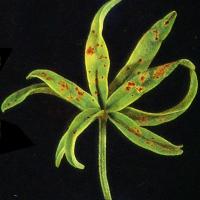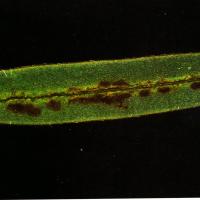Diagnosing zinc deficiency in narrow-leafed lupins
Lupins are less susceptible to zinc deficiency that wheat or barley
What to look for
- Plants with bunchy pale new leaves.
- Deficiency will vary with soil type, with early deficiency possible in newly limed soils.
Paddock
- Markedly pale new leaves with shortened petioles, causing a bunchy appearance.
- Leaflets of pale new leaves develop brown spots along their midribs.
- Leaflets become bent and curled, often backwards towards the petiole.
- Plants recover as they approach flowering.
Plant
What else could it be
| Condition | Similarities | Differences |
|---|---|---|
| Diagnosing sulphur deficiency in narrow-leafed lupins | Pale clumpy new growth | No leaf lesions |
| Diagnosing iron deficiency in narrow-leafed lupins | Pale new growth | More likely on wet soils |
| Diagnosing group B herbicide damage in narrow-leafed lupins | Stunted plants with pale new leaves | Plants die back severely with yellower younger leaves |
Where does it occur?
- Most sandy surfaced soils required copper and zinc when initially cleared for agriculture
- Zinc is relatively immobile in soil and becomes unavailable to crops in dry soil.
- Where soil levels are marginal, zinc deficiency may be induced by applications of lime
Management strategies

Spraying foliar
- Foliar spray (effective only in current season) or soil fertiliser drilled with the following crop.
- Zinc foliar sprays need to be applied as soon as deficiency is detected to avoid irreversible damage.
- As zinc is immobile in the soil, topdressing is ineffective, as it would only be available to the plant when the topsoil is wet.
- Zinc drilled deep increases the chances of roots being able to obtain enough in dry seasons.
- Zinc has a 15 to 20 year residual life in soil.
- Zinc present in compound fertilisers often meets the current requirements of the crop.
How can it be monitored?

Soil test
- As zinc is immobile in the plant, young shoot or young leaf sampling is most accurate. The critical concentration for the youngest open leaflet before flowering is 12 to 14 mg/kg.
- A DTPA zinc soil test provides at best a rough guide to soil zinc status for cereals. The critical concentration varies with soil type.
See also
Further information
Where to go for expert help
Page last updated: Wednesday, 6 May 2015 - 11:14am




